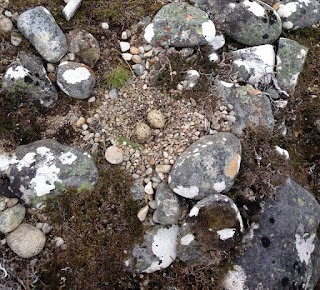I’ve been interested in nesting now for about 3 years (this is my fourth year of looking for nests and my third of sending records to the BTO) and it just gets more exciting the more I learn.
 |
| Common Gull nest by Ellis Lucas |
I really enjoy seeing new birds and will travel a reasonable distance to see something unusual or a rarity. With nesting it is completely different, the excitement I feel whenever I find a new nest is just as exciting, whatever the bird. To have a peek into its world is great. Watching the dedication of a bird sitting through terrible weather to keep the eggs/chicks warm makes me feel so sorry for them and realise what a comfortable life I have.
 |
| Common Sandpiper nest by Ellis Lucas |
There are a number of places I go nesting; from my back garden (not many results unfortunately yet), to local farmland, to the Highlands of Scotland (where I go at Spring Half Term). I always carry the BTO’s
Field Guide to Monitoring Nests which gives great info on what to look for and what birds are likely to nest in any given habitat. My favourite record so far and one I found completely by myself was that of a Common Sandpiper. I had noticed a few birds around when walking around a Loch in Scotland and looking through the book provided all the info necessary to understand the bird’s behaviour and know that it was probably on eggs or young somewhere in the area. The book mentioned that they would nest on slopes towards water and sure enough with a little bit of patience, I noticed a Common Sandpiper leave the side of a bank and begin to feign injury – text book nesting behaviour. After a few minutes of searching the area where I had seen the bird, I found my first Common Sandpiper nest! I was delighted.
 |
| Oystercatcher nest by Ellis Lucas |
I have now submitted more than a dozen records and hope to add to that later this year. The book also gives tips on how to find the nests and the best methods of locating them (sometimes tapping vegetation and sometimes just sitting and watching). I have found nests using both methods and other times I have just been very lucky and walked past a bird which has flown off while I'm near, allowing me to find the nest. Using the car as a ‘hide’ is a brilliant way of watching birds like Lapwings and Oystercatchers which readily fly off their nests, making them almost impossible to find. Being quiet, still and patient are all necessary when watching birds back to their nests.
One of the best things about nest recording is that it is a hobby which provides good info for the BTO and can be done whenever there is daylight. Even weeks before the nesting season starts, you can check out birds in a particular area and this gives a good indication of a nest attempt. Earlier this year when out for a walk with my dog, I noticed a Moorhen hanging around a really small pond. The pond had some vegetation near the edge and rushes a little deeper. Good spot to nest I thought. This pond was then dredged by the farmer and a lot of the vegetation was removed. This did not look promising but I noticed the Moorhens (2 this time) about a week later still in the area. Earlier this week (Tuesday 13th April), I found my first Moorhen nest of the year with 6 eggs!
 |
| Dipper nest by Ellis Lucas |
The nest record cards are easy to fill in and provide the BTO with info on things like, species, how many eggs/young, success or failure, when in the year the nest was found, how long the eggs took to hatch/the chicks to fledge, habitat and where in the UK. The records I complete are then sent to the BTO in Thetford where the info is taken from many nest recorders around the country and this gives a clear picture of where certain birds are nesting and the variety of birds in a certain area.
One thing that I am hoping to do this year with the help of a couple of experienced ringers, is to ring the young from the nests I find. I can’t think of anything more exciting than finding a nest very close to home, recording as much as I can about the species (I always make my own notes as well as what the ringer will submit) and learn of its movements. Imagine a Blackbird nesting in your own garden, ringing the chicks and possibly finding out about their presence in another part of the country or even another country if it is recaught. Just incredible!
So apart from it being an exciting hobby and making sure I get plenty of exercise and fresh air, it is playing a valuable part in gathering information on the nesting birds (migrants and resident) of the UK.
To see how you can get involved in nest recording, check out the
BTO Nest Record Scheme webpages where you can also find the
NRS Code of Conduct for nest recorders.
Ellis Lucas,
@ellisethanfox




Great post! It's amazing that you've seen all those different nests. Is there any particular nest you really want to see?
ReplyDelete